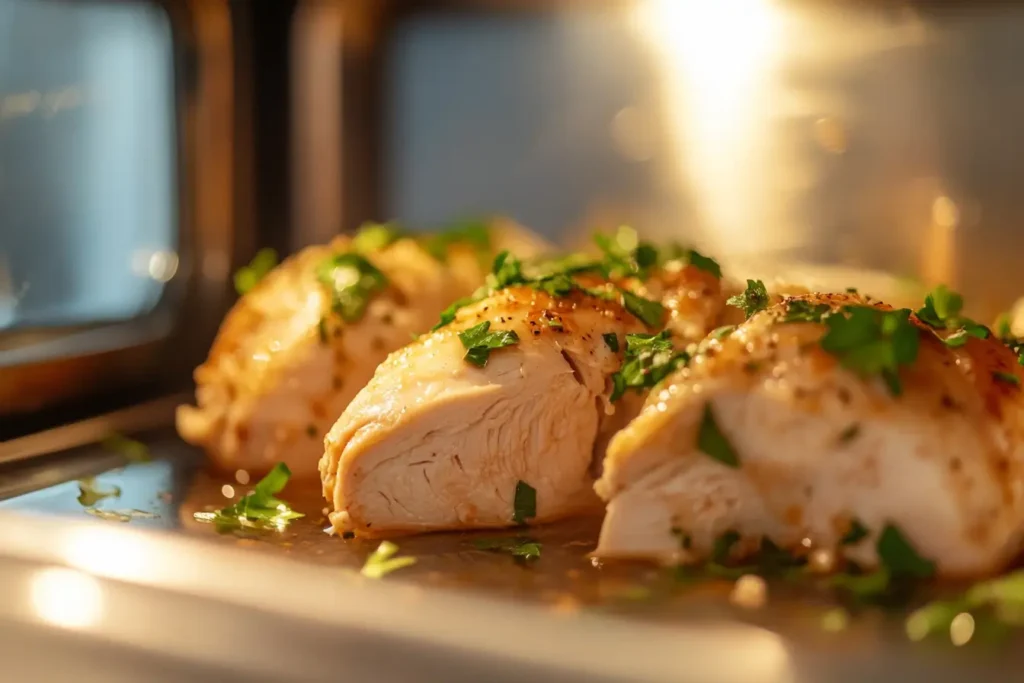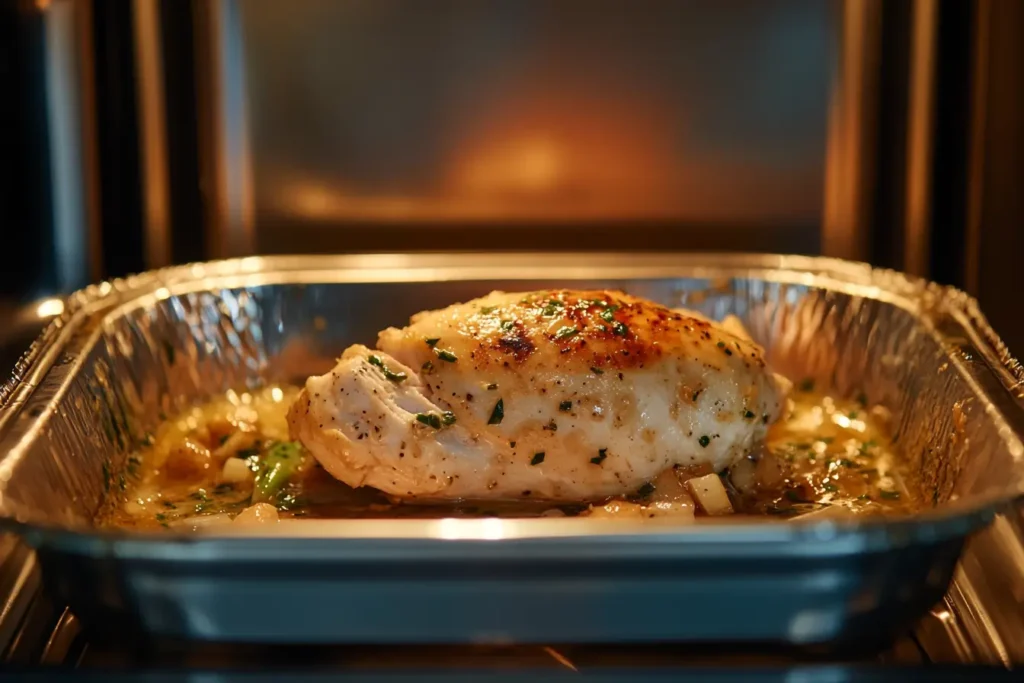
Freezing foods is a convenient way to save time, reduce waste, and enjoy meals later. One popular dish that raises questions about freezing is chicken and dressing—a comforting, homemade recipe often served during holidays or family gatherings. Can you freeze chicken and dressing effectively without losing flavor or texture? Yes, you can! However, it’s essential to use proper preparation, packaging, and storage techniques to maintain its quality.
This guide provides a step-by-step process for freezing chicken and dressing, answers common concerns, offers reheating tips, and explains how to preserve the dish’s original taste and texture.
How to Freeze Chicken and Dressing
Freezing chicken and dressing is simple if you follow the right steps. To ensure that the dish retains its flavor and texture, preparation is key. Here’s how to freeze chicken and dressing properly:
Prepare the Chicken and Dressing
- Cook the Dish Thoroughly: Before freezing, ensure the chicken is fully cooked and the dressing is prepared according to your recipe. Raw or partially cooked food doesn’t freeze as well and could pose a food safety risk.
- Let It Cool Completely: Allow the chicken and dressing to cool to room with the right temperature. Freezing food while it’s still warm can lead to the formation of ice crystals, which may negatively affect the texture.
Portion the Dish
- Divide into Servings: Consider portioning the chicken and dressing into smaller servings before freezing. This makes it easier to thaw only what you need later, minimizing waste.
- Use Freezer-Safe Containers: Place the portions in airtight freezer-safe containers or heavy-duty freezer bags. Ensure there’s minimal air inside to prevent freezer burn.
Label and Store
- Label the Packaging: Write the date and contents on the container or bag. This helps you track how long the dish has been in the freezer.
- Freeze Quickly: Place the chicken in the freezer after sealing. Try to store it in the coldest part of the freezer for optimal preservation.

How Long Can Chicken and Dressing Be Frozen?
Chicken can be stored in the freezer for up to 3 months. While it may remain safe to eat beyond that, the flavor and texture might deteriorate over time. To enjoy it at its best, aim to enjoy the hole dish within this timeframe.
How to Thaw and Reheat Chicken and Dressing
Properly thawing and reheating chicken and dressing is crucial for preserving its taste, texture, and safety. Follow these steps to ensure your dish is as delicious as when it was first prepared.
Thawing Chicken and Dressing
- Refrigerator Method (Recommended):
- Move the frozen chicken and dressing from the freezer to the refrigerator.
- Let it thaw gradually overnight or for 8–12 hours, depending on the portion size.
- This approach ensures even thawing and minimizes the risk of bacterial growth.
- Quick Thawing Option:
- If you’re in a hurry, submerge the sealed container or freezer bag in a bowl of cold water.
- Replace the water every 30 minutes until the dish is thawed. Avoid using warm or hot water, as it can alter the texture and promote bacterial growth.
- Avoid Thawing at Room Temperature: Leaving chicken and dressing at room temperature can increase the risk of spoilage.
Reheating Chicken and Dressing
- Oven Reheating (Best for Texture):
- Preheat your oven to 350°F (175°C).
- put the thawed chicken and dressing in an oven-safe dish. wrappe it with foil to retain moisture and prevent drying.
- Heat for 20-30 minutes, or until the internal temperature reaches 165°F (74°C). Use a food thermometer for accuracy.
- Remove the foil in the last 5-10 minutes if you want a crispier texture on the dressing.
- Microwave Reheating (For Convenience):
- Transfer a portion of the chicken and dressing to a microwave-safe plate.
- Cover it with a microwave-safe lid or damp paper towel to prevent it from drying out.
- Heat on medium power for 2-3 minutes, stirring halfway through. Ensure it’s heated evenly.
- Stovetop Reheating (For Small Portions):
- Put the thawed chicken and dressing into a nonstick skillet and heat over low to medium heat.
- Add a little broth or water to keep it from sticking and to moisten the dressing.
- Stir occasionally while warming until it reaches the desired temperature.
Tips for Reheating
- Add Moisture: If the dressing seems dry after thawing, mix in a little chicken broth, melted butter, or water before reheating. This helps restore its original texture.
- Avoid Overheating: Overcooking can make the chicken rubbery and the dressing crumbly. Always reheat just until warmed through.
- Serve Freshly: Once reheated, consume the dish immediately. Repeated reheating can compromise its quality and safety.

Additional Tips and Considerations for Freezing Chicken and Dressing
Freezing chicken and dressing may seem straightforward, but a few extra tips can help ensure success and maintain the dish’s quality. Here’s what you need to know:
Use the Right Ingredients
- Choosing Bread for Dressing: Cornbread or white bread are popular options for dressing recipes. Both freeze well, but softer breads may soak up more moisture during freezing, which can change the texture.
- Limit Liquids: Use only enough liquid to bind the dressing when preparing it. Adding too much liquid can result in a soggy texture after thawing.
- Herbs and Seasonings: Fresh herbs may lose their flavor in the freezer. Opt for dried herbs to ensure consistent taste.
Freezing Chicken and Dressing Separately
If possible, consider freezing the chicken and dressing separately. This allows you to reheat each component with more precision:
- Chicken: Store chicken pieces in airtight containers. Reheat them on the stovetop or in the oven with a bit of moisture to keep them tender.
- Dressing: Place the dressing in a freezer-safe dish. Reheat it in the oven to maintain its crispy texture. Separating the components is particularly useful if you plan to use them in different dishes later.
This separation is especially helpful if you plan to repurpose the components for other meals.
Avoiding Freezer Burn
Freezer burn can occur when food is improperly sealed, leading to dryness and an altered taste. Here’s how to avoid it:
- Double Wrap: First, wrap the dish in plastic wrap, then place it in a container or bag for added protection.
- Vacuum Seal: If you have a vacuum sealer, use it to remove all air from the packaging for optimal preservation.
- Check Freezer Temperature: Ensure your freezer maintains a constant temperature of 0°F (-18°C) or below.
Ideal Dishes for Freezing Chicken and Dressing
Certain containers are better for freezing meals like chicken and dressing:
- Disposable Aluminum Trays: Ideal for large portions and convenient for reheating in the oven.
- Glass Containers: Sturdy and versatile, safe for both freezing and reheating.
- Freezer Bags: Perfect for saving space and storing smaller portions. Freeze them flat to make stacking easier.
FAQs About Freezing Chicken and Dressing
Can I freeze uncooked chicken and dressing?
Yes, but it’s generally safer and more effective to cook them first. Freezing raw chicken with dressing can cause uneven thawing and cooking. Always thaw and cook uncooked dishes thoroughly before eating.
Can chicken and dressing be refrozen after thawing?
Refreezing is not advisable. Once thawed, chicken and dressing should be reheated and eaten. Refreezing can negatively affect the texture and increase the risk of bacterial growth.
4. Can I freeze stuffing instead of dressing?
Yes, stuffing (cooked or uncooked) can also be frozen using the same methods. However, keep in mind that stuffing often includes additional ingredients like sausage or fruits, which may affect the freezing and reheating process.
5. What’s the best way to freeze leftover chicken and dressing?
The best approach is to portion the leftovers into single servings, seal them in airtight freezer bags or containers, and freeze immediately. Label the portions with the date to keep track of storage time.
6. Is frozen chicken and dressing still good after three months?
While chicken and dressing can technically remain safe in the freezer beyond three months, its quality begins to degrade over time. For optimal taste and texture, consume it within three months.
Conclusion
Freezing chicken and dressing is a practical way to preserve this beloved dish for future enjoyment. By following proper steps for preparation, storage, and reheating, you can maintain its flavor, texture, and nutritional value. Whether you’re planning ahead for a holiday feast or saving leftovers, freezing chicken and dressing can save time and reduce waste.
Remember these key points:
- Cook the dish thoroughly and let it cool before freezing.
- Use freezer-safe containers or bags and label them for convenience.
- Thaw the dish safely in the refrigerator or with cold water, and reheat it to an internal temperature of 165°F (74°C).
With the right techniques, you’ll be able to enjoy chicken and dressing any time of the year without compromising on quality. This method allows you to spend less time in the kitchen and more time savoring meals with loved ones.
